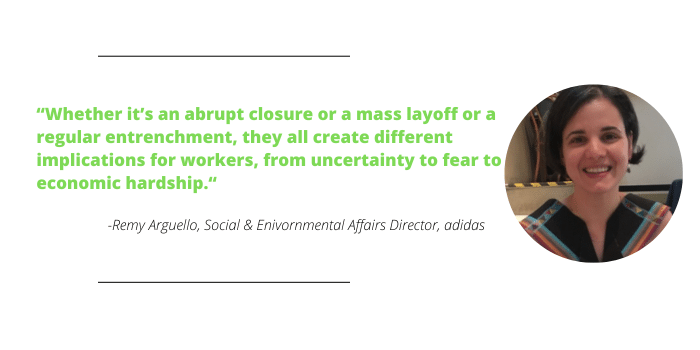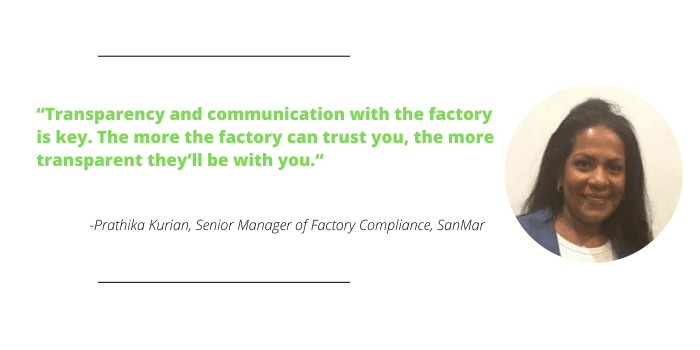“Out of sight, out of mind” can be a dangerous habit to fall into in business. Of all the ramifications of the unpredictability of the global economy and supply chain, one that can sometimes be overlooked is the closure of factories and the life-shifting effect it can have on workers.
The Fair Labor Association led a panel on Tuesday addressing labor risks for workers when the workforce at a factory is downsized or the facility is closed outright. Prathika Kurian, senior manager of factory compliance at SanMar, the No.1 supplier in the inaugural PPAI 100 joined the panel, which also included:
- Remy Arguello, Social and Environmental Affairs Director, adidas
- Evangelina Argueta, Coordinator, Organized Maquila Project (Honduras)
- Marta Zaldana, Secretary General, FEASIES Federación de Asociaciones y Sindicatos Independientes de El Salvador
The webinar was in both English and Spanish.
The Fair Labor Association asserts that over the last few years, hundreds of thousands of workers in the industry have lost their jobs, often in countries where there are weak social protection systems, few alternative job opportunities, and often without receiving their legally owed severance.

The panelists discussed preventing improper exit processes, productive strategies and what true compliance looks like. When downsizing – sometimes referred to as retrenchment – happens, it can be a difficult time, but that does not absolve a company of its responsibilities.
“A policy doesn’t do anything if there’s no accountability,” Arguello says.
Incomplete severance and failed exit processes are becoming prevalent in factory closures. “This is not just confined to Central America,” Kurian adds.
Below are some key takeaways from the panel session, which lasted more than an hour.
Never Lose Your Sensitivity
Brands do not always own the factories abroad producing their goods. Rather, they operate through a system of contracts. Subsequently, workers at those facilities are typically not classified as a brand’s employees. Decision-makers are not interacting with their families or seeing their faces at company events, and not forming a connection to them as individuals.
But that does not change the way reality affects the workers. Arguello warns against becoming numb to their situation.
“Whether it’s an abrupt closure or a mass layoff or a regular entrenchment, they all create different implications for workers, from uncertainty to fear to economic hardship,” Arguello says. “As brands and industries, we have to be really sensitive to these decisions and what effect they have on workers. The biggest fear workers have in Central America is losing their job. Never lose your sensitivity to that.”

Look For Red Flags
Much of a good exit process comes down to prevention instead of reaction. That traces all the way back to the factories a company chooses to work with. Kurian says that getting into business with a factory that has a poor history of compliance will make it difficult to do right by their employees.
“We do look for red flags in their past,” Kurian says. “That’s available online; various reports like human rights reports. There are so many reports out there. Make sure the factory you are onboarding don’t have any unethical practices on their record.”
For SanMar, the compliance team has to give a green light before the company proceeds to work with any factory.
Form Long-term Partnerships
A healthy, lasting partnership is the best way to do good by both sides. Treating factories like one-off services increases the likelihood of improper exit policies.
“From a business perspective, companies can prevent retrenchment by establishing long-term partners as opposed to moving production from one factory to the next,” Arguello. “It’s really difficult to for factories to plan when they have customers coming in and out.”
Transparency and Communication
That relationship should involve transparency and constant communication. At some point, if downsizing is occurring, that is not the time to pare down the communication. It is actually crucial during this stretch.
Kurian advises providing a timeline that works for the factory and your brand in order for everyone to be aligned.
“Transparency and communication with the factory is key,” Kurian says. “I cannot stress enough. The more the factory can trust you, the more transparent they’ll be with you. Transparency on finance is very important. There is no other way for us to know if the factory is financially stable. The trust you build is the most important.”

A Third Party Can Bring Checks And Balances
Kurian admits that this can be difficult in regions like Central America, but bringing in a third party to ensure that both sides are in compliance can provide checks and balances to an exit process.
“Another challenge is finding a third party that can monitor the exit process or make sure the severance was paid correctly,” Kurian says. “In Central America, when the actual time to pay severance comes up, you have to make sure the calculations are done the right way.”
Work With Governments Or Institutions
In some Central American countries, there is little recourse or prevention when it comes to workers being let go or downsized improperly. As brands utilizing the population of these places, there is some responsibility to counter that possibility rather than enable it.
Whether it’s the government or nonprofit organizations, brands can collaborate, or at least communicate, in order to help build a better structure.
“We need to work with governments and other institutions to ensure that there are proper mechanisms in place for workers,” Arguello, “not just to ensure that the entrenchment processes are done correctly, but that when they’re not, the government is properly equipped to address any gaps. We tend to react when a retrenchment happens instead of finding a solution that can be systematic but also sustainable for future cases.”


